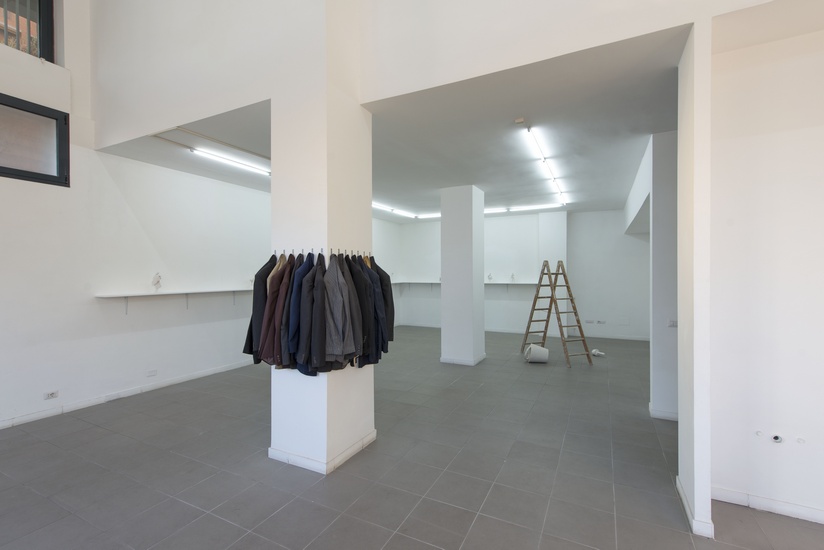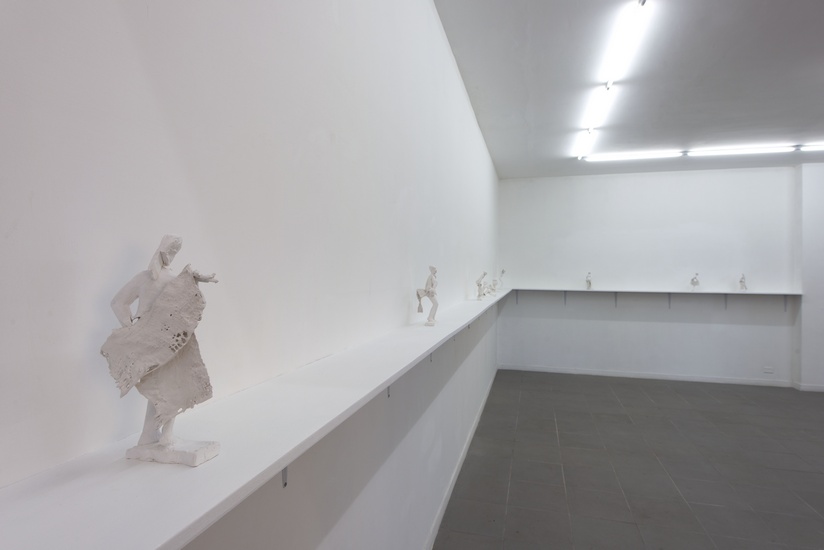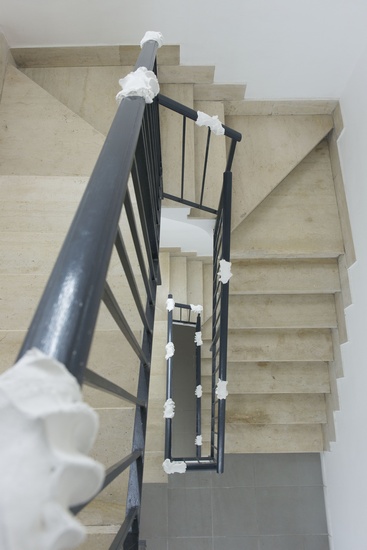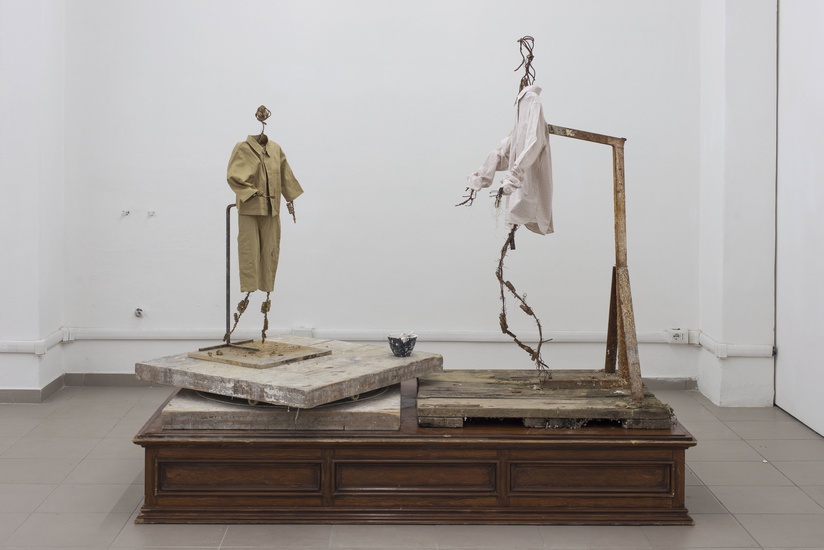Dominik Lang
09.10.2015 – 05.12.2015
Exhibition Views

Naked figures, dressed figurines, 2015, installation view at The Gallery Apart, Rome, photo by Giorgio Benni 
Naked figures, dressed figurines, 2015, installation view at The Gallery Apart, Rome, photo by Giorgio Benni 
Naked figures, dressed figurines, 2015, installation view at The Gallery Apart, Rome, photo by Giorgio Benni 
Naked figures, dressed figurines, 2015, installation view at The Gallery Apart, Rome, photo by Giorgio Benni 
Naked figures, dressed figurines, 2015, installation view at The Gallery Apart, Rome, photo by Giorgio Benni 
Naked figures, dressed figurines, 2015, installation view at The Gallery Apart, Rome, photo by Giorgio Benni 
Naked figures, dressed figurines, 2015, installation view at The Gallery Apart, Rome, photo by Giorgio Benni 
Naked figures, dressed figurines, 2015, installation view at The Gallery Apart, Rome, photo by Giorgio Benni 
Naked figures, dressed figurines, 2015, installation view at The Gallery Apart, Rome, photo by Giorgio Benni 
Naked figures, dressed figurines, 2015, installation view at The Gallery Apart, Rome, photo by Giorgio Benni 
Naked figures, dressed figurines, 2015, installation view at The Gallery Apart, Rome, photo by Giorgio Benni 
Naked figures, dressed figurines, 2015, installation view at The Gallery Apart, Rome, photo by Giorgio Benni 
Naked figures, dressed figurines, 2015, installation view at The Gallery Apart, Rome, photo by Giorgio Benni
Works


Clocks going backwards (fazes of work), (detail),2014, plaster, Rome, photo by Giorgio Benni 
Clocks going backwards (fazes of work), (detail), 2014, plaster, Rome, photo by Giorgio Benni 
Absent author , 2015, clothes, shoes, enviromental dimensions, photo by Giorgio Benni 
Group whisper, 2015, 26 jacket, metal hooks, colomn, enviromental dimensions, photo by Giorgio Benni 
From series: Study of a pre-determined movement, 2015, plaster, fabric , shelf, photo by Giorgio Benni 
From series: Study of a pre-determined movement, 2015, plaster, fabric , shelf, photo by Giorgio Benni 
From series: Study of a pre-determined movement, 2015, plaster, fabric , shelf, photo by Giorgio Benni 
From series: Study of a pre-determined movement, 2015, plaster, fabric , shelf, photo by Giorgio Benni 
From series: Study of a pre-determined movement, 2015, plaster, fabric , shelf, photo by Giorgio Benni 
From series: Study of a pre-determined movement, 2015, plaster, fabric , shelf, photo by Giorgio Benni 
From series: Study of a pre-determined movement, 2015, plaster, fabric , shelf, photo by Giorgio Benni 
From series: Study of a pre-determined movement, 2015, plaster, fabric , shelf, photo by Giorgio Benni 
From series: Study of a pre-determined movement, 2015, plaster, fabric , shelf, photo by Giorgio Benni 
From series: Study of a pre-determined movement, 2015, plaster, fabric , shelf, photo by Giorgio Benni 
Reconstruction, 2015, ladder, plaster, enviromental dimensions, photo by Giorgio Benni 
Reconstruction, (detail), 2015, ladder, plaster, environmental dimensions, photo by Giorgio Benni 
Descending the stairs, 2015, plaster, banister, environmental dimensions, photo by Giorgio Benni 
Descending the stairs, (detail), 2015, plaster, banister, environmental dimensions, photo by Giorgio Benni 
Dressed nudes (pink), 2015, pencil on paper, fabric, cm 42 x 32, photo by Giorgio Benni 
Dressed nudes (blue), 2015, pencil on paper, fabric, cm 42 x 32, photo by Giorgio Benni 
Dressed nudes (black and white), 2015, pencil on paper, fabric, cm 42 x 32, photo by Giorgio Benni 
Random meeting, 2015, wooden platform, metal construction, clothes, cm 200 x 240 x 123, photo by Giorgio Benni 
Random meeting, (detail), 2015, wooden platform, metal construction, clothes, cm 200 x 240 x 123, photo by Giorgio Benni 
Sculptor, 2015, plaster, table, real dimensions, photo by Giorgio Benni 
Three figures, 2015, clothes, shoes, wardrobe, real dimensions, photo by Giorgio Benni 
List of figurative sculptures of Josef Vaclav Myslbek from the collection of the National gallery in Prague, 2015, print, 21 x 29,7 cm
The Gallery Apart is proud to present the second solo exhibition by Dominik Lang, who two years ago inaugurated the current gallery space in the Ostiense neighborhood with a monumental work that beautifully captured and exalted the internal geometries of the gallery architecture, thanks to a language and to a research committed to the interpretation of space and time through works always physically framed in a given context and evocative of experiences and personalities from the past. Arrived in Rome on the wave of the great success of The Sleeping City, the large-scale installation presented in the Czech and Slovak Pavilion during the 54th Venice Biennale, between the first and the second Roman shows Lang debuted an impressive series of exhibitions in well-known public and private institutions worldwide, such as the solo shows hosted at the National Gallery in Prague, at the MUMA in Melbourne, at INHOTIM’s Galeria Lago in Belo Horizonte, at the Czech Center New York, at the Kunsthaus Dresden.
Naked Figures, Dressed Figurines – the title of the exhibition – suggests a new slight, though meaningful, shifting of the centre of gravity in the artist’s interest. In Lang’s works, the human figure has always been the main element around which the context revolves. The relationship between man and surrounding space, built or evoked through unsettling architectural modifications, and the relationship between man and time, through the ideal, and at times even factual, reference to the artworks of predecessor artists, find new life in a research that this time investigates the relationship between man, as sculpted figure, and the artist himself. The field of investigation, so universal but also so intimate, drives Lang to consider and therefore to use once again the sculptures of his late father artist Jirí Lang (1927–1996), with an approach to the sculpted figure that highlights the theme of the exhibition, which is the relationship between the model and its representation, between sculpture and space, between the art-making process and the artist.
Dominik Lang develops the theme by interconnecting the sculptures with each other, working on the idea of copy and playing with scale representations, skillfully manipulating the humane figure through interventions of segmentation and fragmentation, providing the viewer with the perception of new coordinates and never-seen-before compositions, presenting sculptures related to different phases of the creative process. Aim of the artist is to create and show a whole range of figures which as duplicates draw life from the real model, wherefrom the creative process started to the formless and abstract mass of clay, through a series of sculpted figures that seem to return to the real original model.
While the small figures inhabiting a shelf and entitled Study of a pre-determined movement show one figure being reconfigured, changing its pose, gestures that allow her to dress or take off the clothes, the work Reconstruction translates a small sculptural model of a man-painter on a ladder into an actual situation in the gallery space in which the only indicators pointing back from the reality to the world of sculptural models and artifacts is a bucket and brush made of plaster, tools that become their sculptural representation. The same happens to sculptor’s tools made of plaster and laid on a table desk. Other figures are represented through clothes and their arrangement in concrete spaces-the wardrobe or a column. A walk down the stairs is emphasized by the imprints of a hand touching the plaster on the banister. The author acts as a choreographer of figures in the space, as a sculptor or a surgeon that gives the sculpted figures a different shape as well as a performer himself when he, in a moment prior to the start of the exhibition, takes off his clothes and walks through the gallery naked as if a change of roles was needed-the author becoming a model.
Naked Figures, Dressed Figurines is therefore an aesthetic experience and at the same time it is a keen re-evaluation of the humane figure, whether it is real or sculpted, whether it is an original or a copy, whether it comes from the artist or from his father. Lang urges the viewer not to perceive the works individually as a series of static figures, but rather as artworks that provoke a physical sensation and create an interplay between the viewer and the sculpture, in a sort of a continuous movement of the figures through the exhibition space.
A project supported by Czech Centre Milan.
The Gallery Apart è orgogliosa di presentare la seconda personale in galleria di Dominik Lang, artista che ormai due anni e mezzo fa inaugurò gli attuali spazi dell’Ostiense con un’opera monumentale che mirabilmente introdusse ed esaltò l’architettura e le geometrie interne della galleria, grazie ad un linguaggio e ad una ricerca votate all’interpretazione dello spazio e del tempo attraverso lavori sempre fisicamente contestualizzati ed evocativi di esperienze e personalità artistiche del passato.
Giunto allora a Roma sull’onda emozionale ancora forte e presente di The Sleeping City, la sua straordinaria rivisitazione del Padiglione ceco e slovacco alla 54a Biennale di Venezia, nel periodo intercorso tra le due mostre romane Lang ha collezionato una eccezionale sequenza di mostre in importanti istituzioni pubbliche e private in tutto il mondo, tra cui le personali presso la Galleria Nazionale di Praga, il MUMA di Melbourne, la Galleria Lago del Centro INHOTIM di Belo Horizonte, la galleria del Czech Center di New York, la Kunsthaus di Dresda.
Naked figures, dressed figurines, il titolo della mostra, già suggerisce un nuovo leggero ma significativo spostamento del baricentro dell’interesse dell’artista. La figura umana costituisce da sempre l’elemento attorno a cui Lang fa ruotare il contesto. Il rapporto tra uomo e spazio circostante, costruito o evocato attraverso modifiche architettoniche spiazzanti, e il rapporto tra uomo e tempo, attraverso il riferimento ideale e a volte persino fattuale alle opere di artisti suoi predecessori, trovano nuova linfa in un’indagine che questa volta irrompe nel rapporto tra uomo, nel senso di figura scolpita, e artista stesso. Il campo di indagine, così universale ma anche così intimo, spinge Lang a nuovamente considerare e ancora una volta utilizzare le sculture del padre Jirí Lang (1927–1996), con un approccio alla figura scolpita che sottolinea il tema principale della mostra, vale a dire la relazione tra modello e sua rappresentazione, tra scultura e spazio, tra il processo di creazione dell’opera e l’artista che la sta realizzando.
Dominik Lang esaurisce il tema ponendo le sculture in correlazione tra loro, lavorando sull’idea di copia e giocando con le rappresentazioni in scala, manipolando la figura umana mediante interventi di segmentazione e frammentazione, proponendo alla percezione dello spettatore nuove coordinate e inedite composizioni, presentando sculture corrispondenti a diverse fasi del processo di creazione. L’obiettivo dell’artista è di generare e mostrare un’intera gamma di figure che muovano dal modello vivo, reale da cui il processo creativo è iniziato fino all’ammasso informe e astratto di creta, passando per una serie di forme di figure scolpite che arrivino fino a ridiventare quasi la figura reale di partenza.
Mentre alcune piccole figure posizionate su un lungo scaffale, un lavoro intitolato Studio di un movimento predeterminato, mostrano una figura progressivamente riconfigurata, che modifica la sua postura, mediante gesti che le permettono di vestirsi o svestirsi, l’opera Reconstruction traduce una piccola scultura raffigurante un pittore su una scala in una situazione reale nello spazio della galleria in cui gli unici indicatori che riportano indietro dalla realtà al mondo dei modelli scultorei e dei manufatti sono un secchio e pennello in gesso, strumenti che diventano la rappresentazione scultorea di se stessi. Lo stesso accade per gli strumenti dell’artista, scolpiti in gesso e lasciati giacere su un tavolo. Altre figure sono rappresentate attraverso i vestiti e la loro disposizione in spazi concreti, come un armadio o una colonna. Una passeggiata lungo le scale è sottolineata dalle impronte di una mano che tocca del gesso sulla ringhiera. L’autore agisce come coreografo delle figure nello spazio, come uno scultore o un chirurgo che conferisce alle figure scolpite una forma diversa e nel contempo come un performer quando, a mostra non ancora inaugurata, si è spogliato ed ha effettuato nudo una passeggiata attraverso la galleria, come in uno scambio di ruoli in cui l’autore diventa il modello.
Naked figures, dressed figurines si propone dunque come un’esperienza estetica ma nel contempo anche di riappropriazione di una forte consapevolezza della figura umana, sia essa reale o scolpita, sia essa originale o copia, sia essa dell’artista o di suo padre. Lang spinge lo spettatore a non percepire le opere individualmente come una serie di figure statiche, ma come opere con cui entrare in relazione corporalmente in una sorta di circolazione movimentata delle figure nello spazio.
Il progetto è stato realizzato con il supporto del Centro Ceco di Milano.
share on